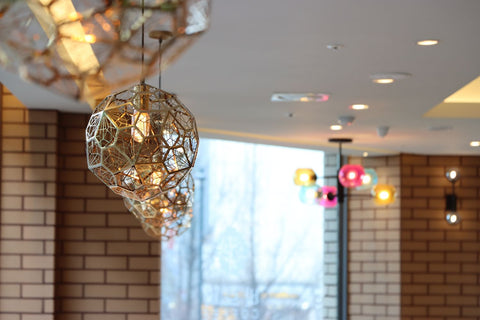Lighting is a powerful tool that can completely transform the feel of a room. From the brightness of the light to the type of bulb used, lighting has the power to evoke emotions and different moods.
It can also be used to create a certain atmosphere and draw attention to certain features. Lighting is more than just a practical tool; it can also be used to make a statement about who you are and what you value.
Whether you’re looking to install something whimsical and unique or to create a sophisticated and modern look, the right lighting can make all the difference. Knowing how to select the right lighting and how to arrange it can help you create a space that’s reflective of your true style and personality.
What is the purpose of lighting in a home?
Lighting serves many purposes in the home, including illumination, aesthetics, and safety. Illumination is, of course, the primary function of any light fixture. It can be used to provide general light, accentuate certain architectural features, or create a specific mood. For example, ambient lighting is used to create a uniform and general level of brightness throughout a space.
Accent lights are used to draw attention to specific architectural features, like artwork or wall decorations. Mood lighting is used to provide the right ambiance for different activities. Safety is another important aspect of lighting, and most people are familiar with the need for ample lighting in stairwells and hallways. Lighting can also be used as a security feature, especially in outdoor spaces.

Types of lighting options
Wall Lighting - Wall lighting is a popular choice for many rooms, including kitchens, bathrooms, and home offices. It can be used to create a defined look and draw attention to architectural details. Wall lighting comes in many different styles, from rustic to modern.
Task Lighting - Task lighting is used to provide focused light on specific areas, such as a desk or reading chair. It may be used to highlight architectural features or create a reading nook in a child’s room.
Decorative Lighting - Decorative lighting is often used to add a decorative or ornamental element to a room. Chandeliers and pendant lights are some of the most common decorative lighting options.
Recessed Lighting - Recessed lighting is commonly found in hallways and stairwells as well as kitchens. It may be used as general lighting or to highlight certain architectural features.
Outdoor Lighting - Outdoor lighting is used to illuminate certain areas of an outdoor space, such as paths, patios, and gardens. It comes in many different styles, including ornamental lanterns, spotlights, and floodlights.

Benefits of different types of lighting
General Lighting - General lighting provides a uniform level of brightness throughout a room. It can be used to create a relaxing atmosphere or a sense of intimacy.
Accent Lighting - Accent lights draw attention to specific architectural features, like artwork or a fireplace. It can be used to create a dramatic or bold look and can help to separate different areas of a room.
Mood Lighting - Mood lighting is used to set the right tone for different activities, such as reading or dining. It can be used to create a playful or whimsical mood.
Security Lighting - Security lighting is used to illuminate areas, such as pathways and walkways, that are typically dark and pose a safety risk. It can also be used to draw attention to architectural features or decorative elements.

How to select the right lighting for your home
When selecting the right lighting for your home, it’s important to consider the function and purpose of each light fixture. It’s also important to consider the aesthetic of the space. If you’re trying to create a specific style in a room, like a rustic farmhouse look, it’s helpful to select lighting that fits that aesthetic. When selecting the right lighting for your home, consider the following:
Function - What is the purpose of this light fixture? Is it purely decorative? Is it used to provide general lighting or to highlight specific architectural details?
Style - What is the look and aesthetic you’re trying to achieve? Is the lighting you’re considering reflective of the style you’re trying to achieve?
Environment - Where is the lighting being used? What type of room is it being used in? What other elements are in the room?

How to create the perfect lighting arrangement
Creating the right lighting arrangement can be challenging, but it can also be a lot of fun. There are many different ways to select and arrange your lighting, depending on the look and feel you’re trying to achieve. If you’re struggling to find the perfect arrangement, here are a few tips that can help you find the right lighting for your space:
Create a Mood Board - If you’re struggling to find the right lighting, it might help to create a mood board. A mood board is a visual board that features different images, colors, and elements that you like.
Create an Outdoor Lighting Plan - Outdoor lighting can be an easy way to add color to a space, especially if you have a colorful garden. By choosing the right colors and styles, you can add color and vibrancy to your home without having to repaint.
Plan Your Lighting Around a Theme - Lighting can be a great way to add a decorative element to a room. If you’re trying to create a specific look, like a beach house vibe, it can be helpful to select your lighting based on that theme.

Creative lighting ideas
Create Mood Lighting - Mood lighting is used to set the right mood in a space. It is often used in dining rooms and living rooms, providing a soft and romantic feel.
Use Color to Create a Mood - Colors can be used to set the right mood. By choosing the right colors for your lighting, you can create a specific mood in a room. You may want to use one color or a combination of colors.
Use Lighting to Create Contrast - Contrast can be used to create visual interest and draw attention to certain architectural features. You may want to use opposing colors or styles in your lighting to create contrast.

Benefits of modern lighting technology
Dimmer Switches - Dimmer switches allow homeowners to adjust the brightness of their lights. This is especially helpful for mood lighting since it allows you to adjust the brightness of the bulbs.
LED Lighting - LED lighting lasts longer and uses less energy than many other types of lighting. This can help reduce your energy costs and save money.
Smart Lighting - Many home lighting systems are compatible with smart technology. This allows you to control your lighting from anywhere with an internet connection.
Voice Activated Lighting - Voice activated lighting allows you to control your lights with a simple command. This is helpful if you have trouble reaching your lights, like if you have limited mobility.

Common mistakes to avoid when selecting lighting for your home
Failing to Consider the Environment - You must consider the environment in which your lighting will be used. What type of room is it being used in? What other elements are in the room?
Overusing Lights - It’s important to use the right amount of lighting for the space. Too many lights can be overkill and create a messy look.
Overlooking Safety - Safety must always be a priority when selecting lighting for your home. If a light is not bright enough or poorly placed, it could pose a safety risk.
All-or-Nothing Approach - You don’t want to choose a light that completely clashes with the current aesthetic of your home. Rather, you want to find a light that complements your current look and style.








